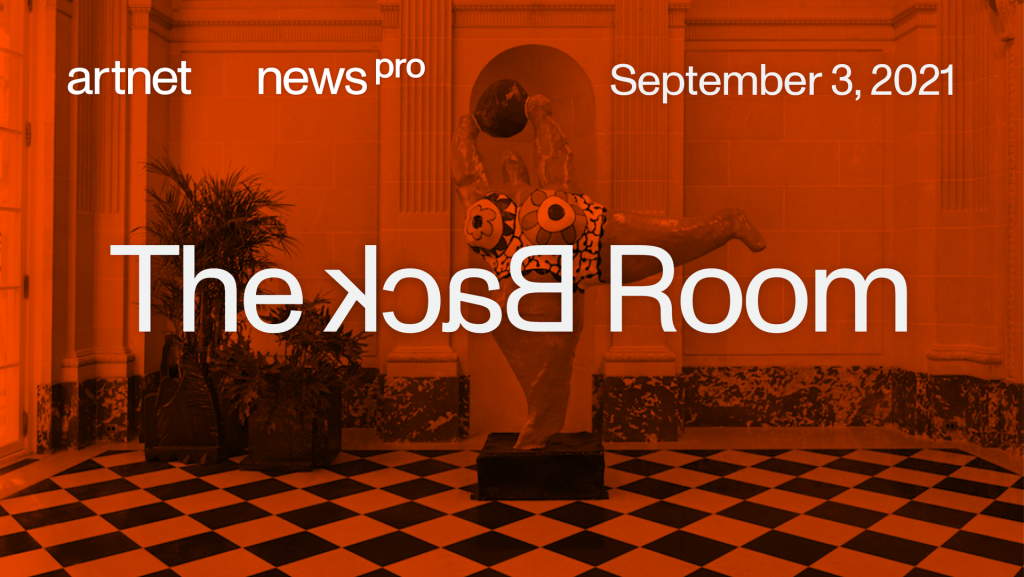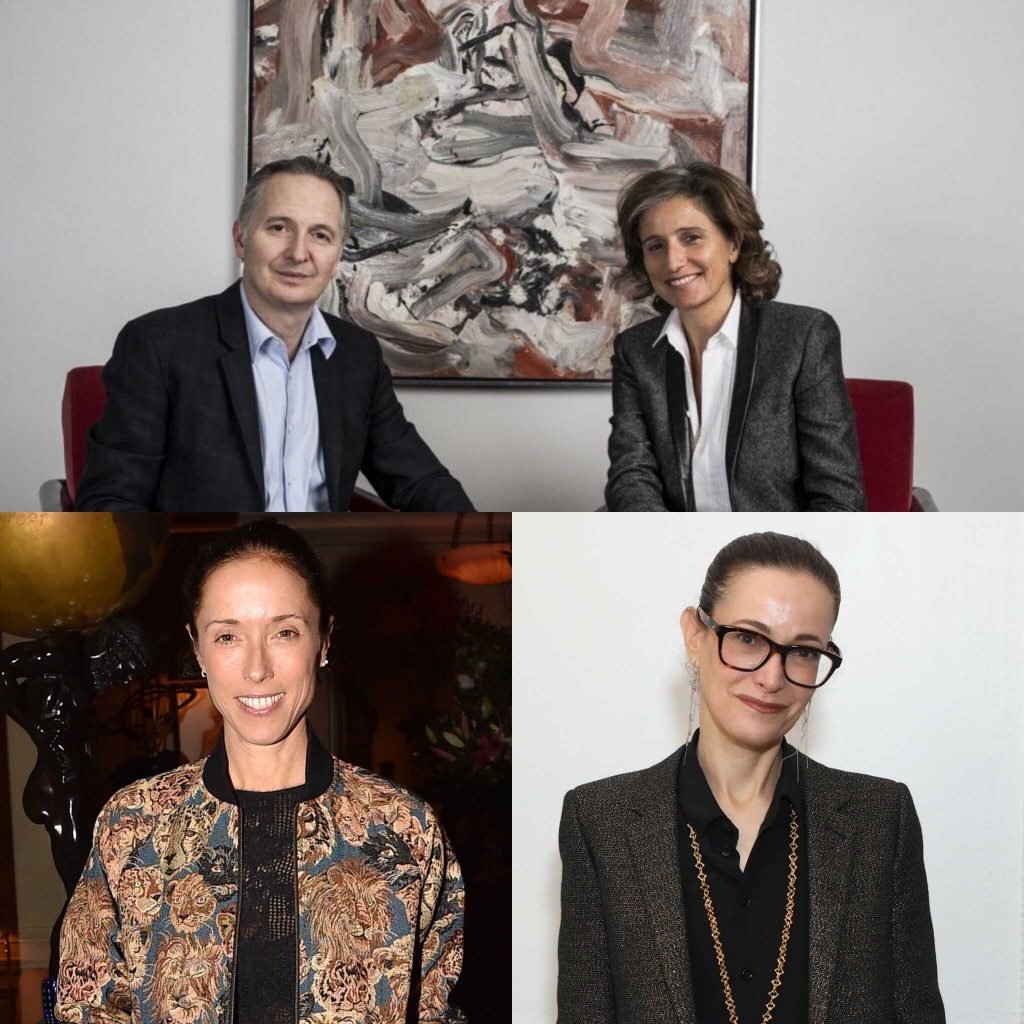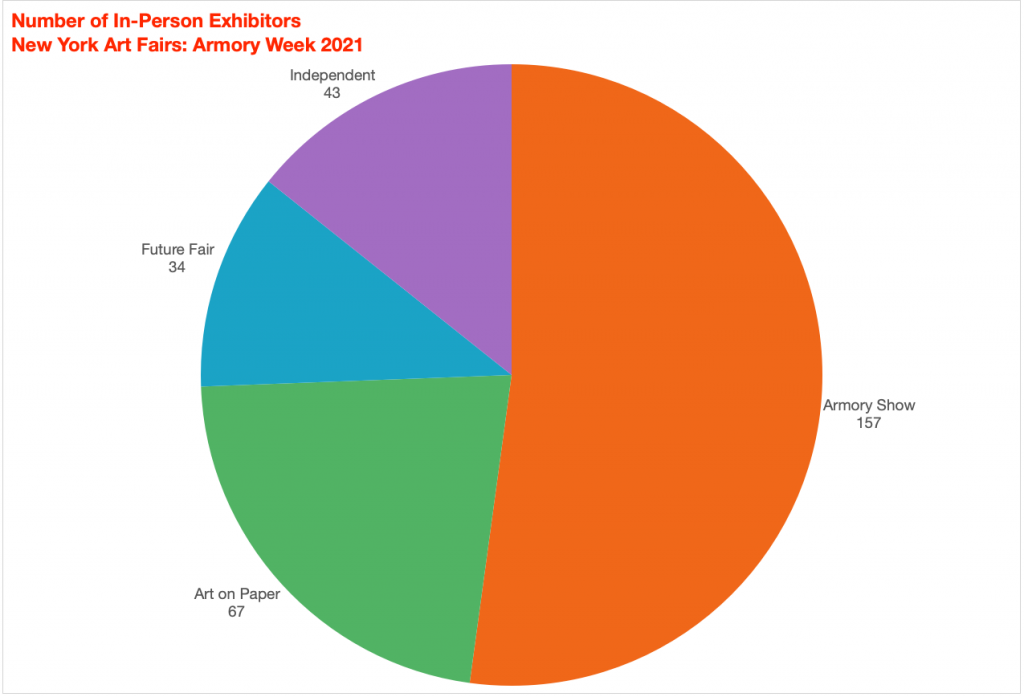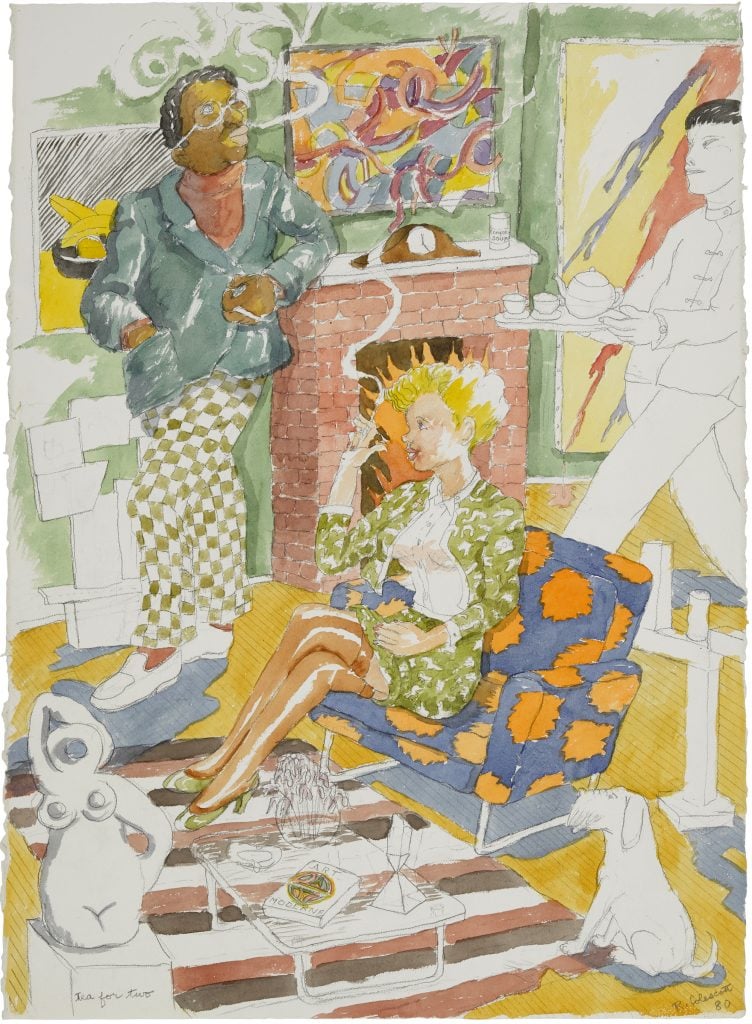The Back Room
The Back Room: Unite and Conquer
This week: four blue-chip dealers join forces, live art fairs step up to the starting blocks, NFTs go Hollywood, and much more.

This week: four blue-chip dealers join forces, live art fairs step up to the starting blocks, NFTs go Hollywood, and much more.

Tim Schneider

Every Friday, Artnet News Pro members get exclusive access to the Back Room, our lively recap funneling only the week’s must-know intel into a nimble read you’ll actually enjoy.
This week in the Back Room: Four blue-chip dealers join forces, live art fairs step up to the starting blocks, NFTs go Hollywood, and much more—all in an 8-minute read (2,139 words).
__________________________________________________________________________________

From top left: Brett Gorvy and Dominique Lévy, Jeanne Greenberg Rohatyn, and Amalia Dayan.
I never imagined that the next installment of the “disrupting the traditional gallery model” narrative would involve an official portrait of Brett Gorvy in white jeans, but here we are.
On Tuesday, the New York Times broke the story that Dominique Lévy, Amalia Dayan, Jeanne Greenberg Rohatyn, and Gorvy are merging into a new venture called LGDR (a mashup of their last initials, if that’s not obvious). The move will see the principals wind down their existing dealerships and start fresh together next year. (Dayan already exited Luxembourg & Dayan, her partnership with Diana Luxembourg, in 2020.)
What is LGDR, exactly? Depends on who you ask. With all due respect, I’m dubious of the revolutionary rhetoric the Times leaned into. Aside from deploying references to “upending” and “disrupting” the infamous “traditional model,” the Paper of Record described the venture as “a consortium that will represent artists, organize exhibitions, advise collectors and broker auction sales.” To which my immediate reaction was, “So… a gallery?”
But my snap take glossed over a deeper relevance teased out in a follow-up story by my colleague Katya Kazakina (who was told by two LGDR principals that rumblings about the merger were “bullshit” and “crazy rumors” four days before the Times published the story with the quartet’s cooperation). Here’s the key excerpt from her piece:
“With the rise of mega-galleries and corporatization in the art world, access to capital is key to success. It looks like the four dealers, already independently wealthy, are pooling their resources for greater impact and as a counter force to behemoths like Gagosian, Zwirner, Pace, and Hauser & Wirth… Unlike mega galleries that are opening splashy spaces on far-flung islands and publishing sumptuous catalogues, however, LGDR seems designed to minimize overhead and maximize profit.”
I think this is a more useful framework to understand most of the known traits defining LGDR, including its decisions to…
Notably, Rohatyn will be the only LGDR principal focused on contemporary art, according to the Times. The other three—who have long been more active in the blue-chip secondary market anyway—will instead focus on geographical regions: Lévy on Europe, Gorvy on Asia, and Dayan on the Middle East (as well as management of the overall partnership).
Dayan Rohatyn Art Services L.L.C., the advisory business formed by Dayan and Rohatyn last year, will also be folded into LGDR, further strengthening its resale biceps.
__________________________________________________________________________________
Although the principals took great pains to frame it differently, LGDR’s business model looks to me like a case of four knowledgeable, experienced dealers simply saying the quiet part about galleries today out loud. It’s less a matter of disrupting the traditional model than of taking the already-expanded contours of the high end and carving away everything but the highest-upside, lowest-downside segments.
It’s as smart as it is surgical. But a central question about the venture’s success will be how long the four “strong personalities with large egos,” in the words of the Times, can rely on their 20-year friendship to keep them united in the face of any and all strategic disagreements to come. Start your office pools now…
__________________________________________________________________________________
Wet Paint will be up later today, but here’s what made a mark around the industry in the meantime.
Art Fairs
Auction Houses
Galleries
Paula Cooper now reps the estate of Luciano Fabro, the Italian sculptor who called himself “the heretic of the Arte Povera church,” in collaboration with the Archivio Luciano e Carla Fabro. The gallery will feature Fabro’s supersized work L’Infinito (1989) at Art Basel Unlimited this month.
Multimedia artist Brook Hsu became the newest talent to join Berlin’s Kraupa-Tuskany Zeidler. (She will also keep working with Hong Kong’s Edouard Malingue Gallery.)
Institutions
The New Orleans Museum of Art, the Contemporary Art Center New Orleans, and other art institutions in the Big Easy cancelled select events but escaped Hurricane Ida with no damage to their collections or buildings. The status of Prospect New Orleans, set to open at 20 locations across the city late next month, remains T.B.D.
New York collectors Elizabeth and Jean-Marie Eveillard gifted 26 works to the Frick Collection, including a sketch for John Singer Sargent’s Madame X and notable works by Goya, Degas, and Caillebotte.
The UCCA Center for Contemporary Art will open its fourth location, this time in Chengdu, in 2024.
The Julia Stoschek Foundation formed a five-person advisory board consisting of artists Meriem Bennani and Arthur Jafa, Whitney Museum curator Chrissie Iles, Haus der Kunst director Andrea Lissoni, and Museum Frieder Burda director Udo Kittelmann.
South Korea’s 2022 budget allots ₩5.8 billion ($5 million) to display and care for late Samsung chairman Lee Kun-hee’s 23,000-work collection; its long-term site in Seoul has yet to be finalized.
The estate of storied filmmaker Barbara Hammer tapped Louky Keijsers Koning, who founded and ran LMAKgallery for 15 years, to be its inaugural executive director.
NFTs and More
From September 2–9, Sotheby’s will hold a single-lot online sale of 101 Bored Ape Yacht Club NFTs plus the means to create a new “Mutant Ape” token. The estimate for the package is $12 million to $18 million.
__________________________________________________________________________________

© Artnet News 2021.
Every art fair on the schedule between now and 2022 had to face the murky question of how much to scale down its offerings for buyers and paying visitors’ peace of mind in a not-quite-post-COVID world. The chart above captures the decisions reached by the four dealer-driven New York fairs that will open their doors next week: the Armory Show, Art on Paper, Independent, and the inaugural Future Fair.
Together the trio will host 301 exhibitors in the flesh. The Armory contributes the vast majority of the total with 157 sellers, or about 52 percent of all booth-renters in the city. (Another 55 exhibitors, mostly from abroad, opted to defer their live participation to 2022 and show exclusively online this fall.) Art on Paper comes in a distant second with 67 exhibitors (22 percent), while Independent and Future Fair roughly split the remainder (with 14 percent and 11 percent, respectively).
For a complete overview of next week’s miles of aisles (including the curator-led Spring/Break Art Show and artist-led Clio Art Fair), click here.
__________________________________________________________________________________
“I’m really going to do my darndest to fight [going to so many fairs]—and then you can make fun of me when I’m right back in the same circuit.”
—Art advisor Lisa Schiff, voicing the tension many more market players are struggling with in a largely vaccinated art world.
__________________________________________________________________________________
New government guidance placed late-unfurling red tape in front of many would-be international participants in Art Basel’s flagship fair later this month. (The Art Newspaper)
__________________________________________________________________________________
Along with surveying the once-again-blooming art-fair landscape, Melanie Gerlis relayed that London gallery the Sunday Painter is launching Gertrude, a side business offering subscribers a chance to rent artworks worth up to £12,000 ($16,545) for up to three months for a £50 ($69) monthly fee. (FT)
__________________________________________________________________________________
What does Facebook’s immersive remote-office software teach us about the viability of virtual-reality art fairs? (Artnet News Pro)
While collaborative online marketplace Gallery Platform Los Angeles has generated more industry attention, its Bay Area cousin 8-bridges is working to make a similar impact on northern California’s art scene. (ARTnews)

Robert Colescott, Tea for Two (1980). Courtesy of Bonhams.
__________________________________________________________________________________
Date: 1980
Seller: Private Collection
Estimate: $20,000 to $30,000
Selling at: Bonhams “Postwar & Contemporary Art x Made in California”
Sale Date: Wednesday, September 15
__________________________________________________________________________________
It seems like ages ago that Robert Colescott’s George Washington Carver Crossing the Delaware (1975) blasted through the artist’s past auction record (and its own high estimate) to reach a premium-inclusive $15.3 million at Sotheby’s New York. And yet, we’re not even four months past the date of that headline-grabbing result—further proof the pandemic has liquefied time into a substance impossible for many of us (or at least me) to keep hold of.
Tea for Two will be the fourth Colescott work to reach the auction block after the late artist achieved his current price apex, according to the Artnet Price Database. The public market for his work appears to have remained healthy but not frothy in the time since. All three subsequent lots sold, with the 1984 painting Gift of the Sea edging above its half-million-dollar top expectation to land at $504,000, and two drawings sized similarly to this one selling in the upper reaches of their respective estimate ranges.
However, those two prior works on paper also featured significantly sketchier, less polished compositions than Tea for Two, which more fully embraces what Bonhams senior specialist and head of sale Sonja Moro calls the “pointed commentary on race and the art market” Colescott is known for. The piece depicts a Black collector surrounded by the works of canonical white male market darlings like Roy Lichtenstein and Frank Stella (as well as a white femme fatale smoking in his armchair). Moro defines the piece as “a stellar example of the artist’s ability to deliver sharp critiques on topics of identity and social power in his inviting, colorful signature style”—one that is as relevant today as it was when Colescott completed it more than 40 years ago.
__________________________________________________________________________________